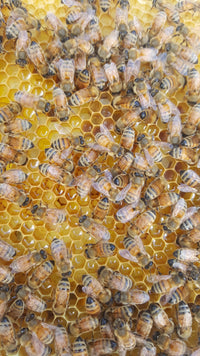The Road to Hell Is Paved With Honey: How the “Save the Bees” Movement Went Sideways
If you’ve been paying attention over the last decade, you’ve noticed the rise of a feel-good sustainability trend sweeping cities, corporate campuses, hotels, and luxury developments: installing honeybee hives to “save the bees.”
It photographs beautifully. It makes for great marketing. Guests love it. The “local honey” story sells.
But here’s the uncomfortable truth most people never hear:
In many urban and suburban areas, installing honeybee hives is not saving the bees. It’s harming them.
Not because honeybees are bad — they’re not. They’re fascinating, socially complex, and essential to our food system. But honeybees are not native to North America. They were brought from Europe in the 1600s for agriculture (Smithsonian Magazine). They belong in managed agricultural environments where crops depend on their pollination — not in fragile developed ecosystems with limited forage.
Yet today, businesses are spending thousands of dollars to install hives for eco-branding, without understanding the ecological consequences.
And like the old proverb says:
The road to hell is paved with good intentions.
🍯 Honeybees Are Livestock. Native Bees Are Wildlife.
Here’s a crucial distinction most people don’t realize:
-
Honeybees = domesticated livestock (at least we try to domesticate)
-
Native bees = wild, essential to ecosystem balance

A single honeybee hive can contain 20,000–80,000 bees.
Native bees, on the other hand, are mostly solitary, nesting individually in soil or stems — and they stay close to home.
Foraging Distance:
| Species | Typical Foraging Range |
|---|---|
| Native Solitary Bees | ~100–300 feet (Xerces Society) |
| Honeybees | Up to 5 miles (UC Davis) |
Now imagine releasing a herd of 80,000 hungry grazers into a neighborhood where tiny native bees have lived and fed quietly for centuries.
Who do you think wins the food fight? The honeybees. Every time.
Studies show that high honeybee density:
-
Reduces available nectar and pollen for native bees
-
Pushes native bees out of their habitat
-
Increases disease transmission through shared flowers
📚 Sources:
-
Journal Ecology: Honeybee presence linked to declines in native bee foraging and reproduction
-
Science (Garibaldi et al., 2013): Wild pollinators increase crop yields more efficiently than honeybees
-
Xerces Society: Honeybee hives compete with wild bees for limited resources
🌼 Native Bees Don’t Make Honey — And That’s Why They’re Better For Nature
One of the most misunderstood facts:
Honeybees over-forage. Native bees take only what they need.
Honeybees collect surplus so their colony can survive winter — which is why we can harvest honey.
Native bees take just enough to feed their offspring. No storage. No surplus. No depletion.
Native bees are also far better pollinators of native plants. Some are specialists that evolved alongside specific flowers — remove them, and entire plant species collapse.
They are quieter heroes, overlooked because:
-
They don’t make honey we can bottle
-
They don’t live in Instagram-friendly hives
-
They aren’t a marketable experience for tourists
But they are the backbone of local ecosystems.
🏨 The Trend of “Hotel Honey” Marketing
Hotels and commercial buildings have caught onto the “local honey” trend. Rooftop hives? Sounds eco-luxury. “Honey from our own bees”? Influencers eat it up.
But here’s the sticky part no one mentions:
If those hives are placed in forage-limited areas (like most cities and suburbs), the “honey” you’re serving is often not floral honey at all.
Honeybees are resourceful — when they can’t find nectar, they will:
-
Raid hummingbird feeders
-
Hit up soda spills and dumpsters
-
Seek out syrups, sugar water, and kitchen waste
When this happens, the honey produced is closer to processed sugar syrup than wildflower nectar.
And if the bees still can’t survive?
They abscond — leave the hive — and go find a new home, often where they’re not wanted.
Meanwhile, native bees?
They quietly starve, decline, and disappear.
✅ So… Do the Bees Need Saving?
Yes. Absolutely.
But saving bees does not mean adding more honeybees to the environment.
It means protecting the bees that are already here and already struggling — our native bees.
If you want to help native bees, try this instead:
✔️ Plant native trees, shrubs, and flowers
✔️ Leave some bare soil and stems for nesting
✔️ Avoid pesticides
✔️ Install native bee hotels (carefully and responsibly)
✔️ Create pollinator corridors on commercial properties
These actions cost far less, require no protective gear, no beekeeper on payroll — and actually improve ecosystem health.
🌱 A Better Way for Businesses to Support Bees
If your business truly wants to earn sustainability credibility, stop chasing honeybee hive optics — and start building native pollinator habitats that restore balance rather than disrupt it.
O’Shun’s Orchard (our parent company) is now partnering with hotels, resorts, developers, and farms to:
-
Assess land for pollinator health
-
Design native pollinator landscapes
-
Install habitats & bee-friendly plantings
-
Support LEED and Green Lodging certifications
Because sustainability isn’t a photo op.
It’s a responsibility — and an opportunity to do real good.
💛 Final Thought
You don’t need a hive to be a hero for the bees.
You just need to support the ones who actually live here.



Leave a comment